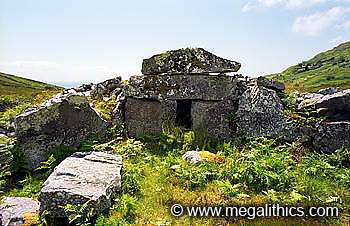
 |
|
Photo Gallery |
|
|
Panoramas |
|
| G 64914 75313 (GPS 10min. entrance). | |
| Visited June 2002 |
The Shalwy Court Tomb, also known as
Muinner Carn, stands in a valley about 6km west of Killybegs, the Atlantic Ocean
is visible to the south. The valley holds two other excavated Court Tombs, Croaghbeg and
the sad ruin of Bavan, in many ways the structure of Shalwy is very similar to that of Croaghbeg. Shalwy was excavated over the period 1967-70, a
long cairn with a full court and gallery was revealed.
The cairn is coffin-shaped with a concave fašade and a straight back, an entrance in the centre of the fašade led to the court. The cairn is about 37m long and has a maximum width of 14.5m, the fašade was about 10m wide and the rear edge of the cairn is about 7m wide. The present maximum height of the cairn is about 2m, but it would have originally been taller than this. The sides of the cairn were retained by dry-stone revetment, the lower levels of which are still
extant. In some places up to three courses of this stonework still exist with heights up to 0.9m.
The front of the cairn including the fašade and the front section of the court has been extensively robbed away in antiquity, so the original form of this section has been deduced by
excavation. The entrance passage through the fašade was about 5m long and opened
directly into the court, this was pear-shaped, necking in towards the gallery entrance
which stands directly opposite the court entrance. The court was about 8.5m long and 7.8m at
its widest, it was lined with large contiguous orthostats. Most of the court stones have gone, a run of 10 stones north of the gallery entrance and 8 stones to the south are all that remain in place. Excavation of the court area produced finds of several flint implements including a leaf-shaped arrowhead.
Prior to excavation the gallery was filled with stones up to the tops of the side slabs, removal of this rubble revealed a 6m long gallery formed by three slabs on each side and a back-stone.
A pair of segmenting jambs sit in the middle of the centre side slabs, a feature repeated in the gallery structure of the nearby Croaghbeg Court Tomb. Access to the gallery was via the entrance jambs, two flat topped pillars about 1.5m high, set 0.85m apart. The jambs are spanned by a
massive double lintel, the lower element is 3.1m long, 1.35m wide and 0.65m thick it is fitted to the tops of the jambs with pad stones, the upper
lintel element is 2.8m long, 1.5m wide and 0.7m thick, its upper surface has a gabled profile. A large rectangular slab was discovered across the front of the gallery, this had been trimmed and shaped and is thought to have been the closing or blocking slab for the gallery entrance, it was broken up and removed during the excavation.
The front gallery chamber is 3m long and 3.4m at its widest just behind the entrance, tapering in toward the rear chamber. The segmenting jambs are set 0.6m apart, with the southern stone slightly in front of the northern, they stand 1.45m and 1.6m tall. A large slab was discovered lying across the front chamber during excavation and this is thought to have been the
lintel that once stood on the segmenting jambs. This stone now lies in the court area just outside of the gallery entrance, it measures 2.2m long, 0.95m wide and
is 0.95m thick.
The rear chamber is 2.8m long and 2.6m at its widest just behind the segmenting jambs, it still has
its original capstone in place. This huge roof-stone is 3.35m long, 2.5m wide and 0.7m thick, with the loss of the support provided by the segmenting lintel
the roof-stone is now rather precariously perched. Because of the dangerous situation of
this stone, the excavators left in place one of the rolled steel joists they had inserted beneath
it as a safety measure. Several corbel stones survive in situ and indeed, some of these still support the rear chamber
roof-stone although many now slant down into the chamber as a result of the
roof-stone's displacement.
Excavation of the upper layers of the gallery floor revealed Iron Age occupation of the rear chamber with finds of metalwork, pottery, a glass bead and a bone comb from these levels in the gallery as a whole. At the old floor level several neolithic flint implements including hollow and end scrapers were found along with a quantity of "featureless neolithic pottery". No finds of human remains were
reported.
Shalwy is just about on par with Croaghbeg for degree of preservation and despite their despoiled courts, both tombs allow the visitor to imagine their intact forms with
the use of only a little imagination. Although access to the tombs is difficult,
two excellent Court Tombs in such close proximity are more than enough reward
for the effort.